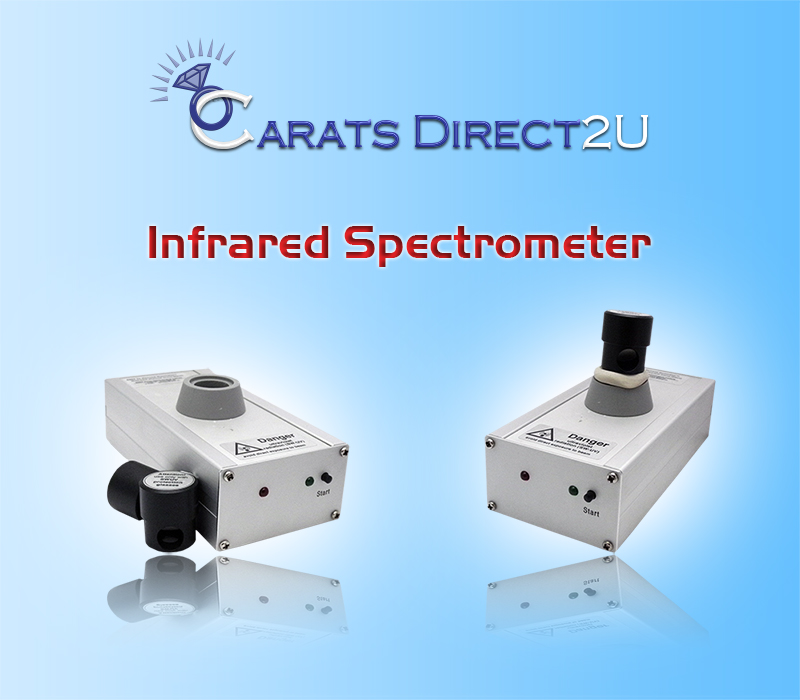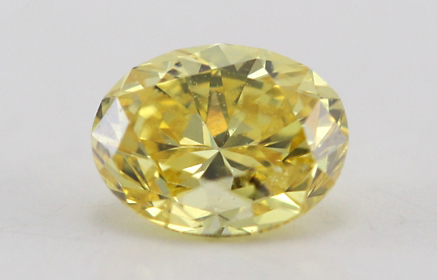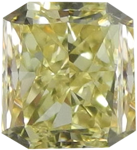Is Buying A Type IIa Diamond A Smart Investment?
The method which scientifically classifies diamonds according to the level and type of chemical impurities inherent in the diamond is called "Diamond Type". Diamonds are categorized into four types: Type Ia, Type Ib, Type IIa, and Type IIb.
These types represent the level of impurities measured at the atomic level, within the crystal lattice of carbon atoms, and require an infrared spectrometer to detect them, unlike the more common inclusions which can be seen by the naked eye or a diamond loupe. Not only is an infrared spectrometer needed to check what type a diamond is, a level of expertise in understanding what one sees when it is examined by an infrared spectrometer. We at CaratsDirect2U.com have the tools and the knowledge to be able to accurately assess the type of diamond and can then appraise them appropriately.

Detection Of Diamond Type
When undergoing examination to determine diamond type, the diamond is wrapped in putty in order to prevent any outside light from disturbing the process of detection. At the same time a small hole is exposed in the bottom of the putty in order that the diamond will refract light. Then it is placed on the infrared spectrometer and covered with a special lens that allows the person examining to avoid looking directly at the very strong (and dangerous) UV light which is emitted by the machinery used to examine the diamond while still being able to determine the diamond type. We have expert jewelers who are experienced in this method of examining diamonds and are-able to quickly check and asses each stone individually, especially when a customer has some concerns as to the type of stone.
It may appear that all diamonds are alike, at least in their basic make-up, however it is important to be aware that there are some notable differences within diamonds at the atomic level. One of the main factors that determine the color of a diamond is the particular characteristics of the trapped foreign objects. In most cases the foreign object is nitrogen (N), the trapped nitrogen atoms. Sometimes diamonds absorb the wavelengths of light which in turn produces a diamond that is light yellow or brown in color. Diamonds that have nitrogen as their primary impurity fall into the category of Type I diamonds, which make up 98% of all diamonds. Diamonds that have a presence of boron (B) or hydrogen (H) cause the diamond to be blue in color. Diamonds with boron as their impurity fall into the category of Type II diamonds.
The chemical buildup of a diamond will determine the classification of the diamond and it will be rated Type Ia, Type Ib, Type IIa, or Type IIb stone. Interestingly enough, one diamond can actually be classified in more than one specific type of diamond category, this is the case of most of the stones in the market today. These are the tests performed by the GIA or the EGL when a diamond is sent in for certification.
In the 1930's it was discovered that different elemental impurities were responsible for the different colors of diamonds. The Nitrogen impurity which is the most common usually occurs in one of two ways. Either in large groups (aggregates) of nitrogen, or as single nitrogen atoms scattered within the diamond's crystal lattice. These two forms of impurities are further broken down into two sub-groups, Type Ia and Ib.
Type Ia Diamonds
Type Ia diamonds are those diamonds that contain nitrogen in aggregates (or large groups). This can be broken down into other sub categories. When these aggregates occur in pairs within the diamond lattice, this is called Type IaA. When they occur in aggregates of four (4) nitrogen atoms they are classified as Type IaB. These types cannot absorb any of the wavelengths of visible light. However, when nitrogen occurs in groupings of three (also called Type IaN3 center), the nitrogen groups absorb the visible light within the blue end of the spectrum, causing a yellow color to appear in the diamond.
Therefore, the nitrogen in Type IaA and IaB diamonds does not affect the
diamond's color, whereas the nitrogen of Type IaN3 center does affect the
diamond's color, causing it to have a yellow tint.

Type Ib Diamonds
Type Ib diamonds are far less common than type Ia. Type Ib account for less than 0.1% of all natural diamonds. Type Ib diamonds are diamonds that contain single nitrogen atoms scattered throughout the diamond's crystal lattice framework. It is this scattering of single nitrogen atoms, which allows the absorption of visible light from the blue end of the spectrum, thus causing an intense yellow color to form. True Canary Yellow Diamonds which are quite rare and valuable are of this type. This atomic formation also causes the formation of Brown and Yellow-Green Diamonds.
Why is a type IIa diamond a better investment diamond than other diamonds?
Less than 1% of the world's diamonds are Type IIa, also called “Golconda Diamonds”, named for the famous Indian mines that gave the world some of its first truly great diamonds in the 16th and 17th century. Scientifically speaking, Type IIa diamonds are almost pure carbon diamonds, containing no significant amount of nitrogen in the crystal lattice. Nitrogen is the impurity in diamond that imparts a yellowish hue. The lack of yellow makes for a pure very valuable colorless (D, E or F) color diamond. Type II diamonds are also divided into two categories, Type IIa and Type IIb. These sub-groups are further categorized separated into two groups, Type IIa diamonds which are capable of conducting electricity and Type IIb diamonds which are not able to conduct electricity.
Type IIa diamonds are colorless, unless they have an inclusion or defect in the structure of the diamond that would allow light absorption to occur. Diamonds of this type can be gray- brown, yellow, pink, light blue, or light green (the two last colors arising from radiation exposure). However, most of the time they are the perfectly colorless diamonds that most people are looking for. This is due to the fact that their structure does not easily absorb short-wave ultraviolet light wavelengths, but instead allows the light to pass through. Such famous diamonds as the Cullinan (the world's largest cut diamond, found in the South African Premier Mine in 1905) and the Koh-i-Noor (Urdu for "Mountain of Light"), which was found in India and now rests in the Tower of London, are type IIa diamonds.
These facts make this diamond type more sought after by the rich and famous, such as the 33.19ct Type IIa “Elizabeth Taylor Diamond” (formerly known as the “Krupp Diamond”) that was purchased in 1968 (before anyone knew that there were different types of diamonds) for $300,000 sold recently at auction for 8.8 million dollars.
We sell loose white
and color diamonds

Why A Customer Should Choose A Type IIa Diamond (If They Can Afford It)
Type IIa diamonds have many special characteristics both on a “geological” level as well as what can be seen by the eye. This causes them to be more sought after and each one to have a unique story. This also causes them to be more valuable, making them a smart choice for an investment. Most of the types IIa diamonds are larger diamonds, mostly over 10 carats. An increase in size signifies a substantial increase in value and price. On average, a diamond that is certified as type IIa is valued at between 2-3% more than the same diamond that is not certified as type IIa.
For example a 5.50ct D color IF (internally flawless) round cut diamond costs on an average retail website $800,000 while the same diamond if it were Type IIa it would cost around $825,000. Many times the customers who are looking for the highest quality diamonds such as VVS1 or IF clarity, D color, an Excellent or Ideal cut, with no fluorescence, will choose the stone that is Type IIa as in order to own what they perceive to be a more "perfect" diamond.
Type IIb Diamonds
Type IIb diamonds are similar to Type IIa diamonds in terms of the lack of, Nitrogen atoms which are contained in the structure of these stones. However, they are infused with the addition of Boron, which makes these stones so unique. The Boron element is known to be the greatest cause of the desirable blue tone within the stone. In fact, colorless stones often look better than their actual color grade and fancies of this class are often found with light blue or gray dominant colors.
Summary
- Type I diamonds are the most common. They represent 98% of all natural diamonds and have detectable traces of Nitrogen.
- Type Ia diamonds contain clusters of Nitrogen atoms throughout the crystal structure of the stone. They tend to emit a yellowish tone.
- Type Ib diamonds contain Nitrogen atoms as well. These atoms are all singular as opposed to clustered groups. These stones are 0.1% of all diamonds and emit a strong yellow, orange, brown and even green color tone.
- Type IIa diamonds are the most valuable and consequently are very collectable items. They contain either very little or no Nitrogen atoms in the crystal structure of the stones. White stones are exceptionally colorless and fancy colored diamonds are often found with a brown, purple, or pink tone. They represent only 1% - 2% of all diamonds.
- Type IIb diamonds contain elements of Boron within the structure. As a result, they often emit a blue or gray tone. They represent only 0.1% of diamonds. And consequently they are also very valuable.
To conclude, Type IIa and Type IIb stones are the most unique and therefore collectable items. Especially in the case of fancy colored diamonds. Since no stones are exactly alike, it is important to assess each diamond individually. One should never assume that a diamond will be perfect because it is graded a specific class or that it is worthless because it is of the more common type stones.
Maybe the diamond you are wearing right now is a type IIa and you don’t even know it. Take it to your local jeweler or send it to a lab to get it check and certified if it is you just made a huge amount of money just by reading this article.
If you are interested in purchasing a Type IIa (or any other type of diamond) in any shape size or color and have questions, please contact us at 1-800-557-7095 or sending us an email to [email protected].



